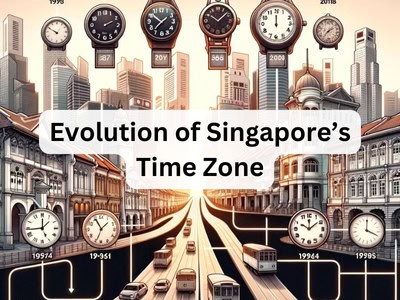This post is also available in:
![]() 简体中文 (Chinese (Simplified))
简体中文 (Chinese (Simplified))
History of Singapore’s Time Zone Evolution
 Since 1905, Singapore has changed time zones 6 times. In the early days, time-ball was used in Singapore back in the early days to tell time. During then, Singapore used time-ball on Fort Canning and Mount Faber, this is to enable sailors to check with their chronometers by the falling ball at 1300 hours daily. During the Second World War, the Public Works Department (PWD) cut the masts down as the masts formed an “ideal” markers’ for artillery. After the war, the time-ball was rendered redundant as most ships had wireless to give them time signals. Singapore was 7 hours ahead of GMT from 1905 to 1932, Then from 1933 to 1941, clocks were moved forward 20 minutes for daylight savings, however, instead of 20 minutes, it was changed to 30 minutes in 1941 to 1942. In World War II, during the Japanese occupation, our clocks were synced with Tokyo and so we were 1 hour and 30 minutes ahead of the previous time zone. Once the occupation ended, it was reverted back to 7 hours and 30 minutes ahead of GMT. Later in 1982, our clocks were synchronized with our neighbour, Malaysia.
Since 1905, Singapore has changed time zones 6 times. In the early days, time-ball was used in Singapore back in the early days to tell time. During then, Singapore used time-ball on Fort Canning and Mount Faber, this is to enable sailors to check with their chronometers by the falling ball at 1300 hours daily. During the Second World War, the Public Works Department (PWD) cut the masts down as the masts formed an “ideal” markers’ for artillery. After the war, the time-ball was rendered redundant as most ships had wireless to give them time signals. Singapore was 7 hours ahead of GMT from 1905 to 1932, Then from 1933 to 1941, clocks were moved forward 20 minutes for daylight savings, however, instead of 20 minutes, it was changed to 30 minutes in 1941 to 1942. In World War II, during the Japanese occupation, our clocks were synced with Tokyo and so we were 1 hour and 30 minutes ahead of the previous time zone. Once the occupation ended, it was reverted back to 7 hours and 30 minutes ahead of GMT. Later in 1982, our clocks were synchronized with our neighbour, Malaysia.
Daylight Saving Time
Currently, Singapore does not observe daylight saving time in the traditional sense due to its tropical location. In 1933, a 20-minute off-set was introduced on an annual basis by the Legislative Council of the Straights Settlements. Daylight Saving Ordinance 1920 was introduced but was later abandoned. This is to introduce a 30-minutes offset or seven and a half hour advance of Greenwich mean time. In 1932, Sir Arnold Percy Robinson raised the idea of a 20-minute offset again as the earlier attempt was abandoned which was proposed by Sir Laurence Guillemard for a 30-minute offset. On 26th September 1932, Daylight Saving Ordinance 1932 was introduced. The Ordinance was passed at a meeting of the Legislative Council, held on December 5th, 1932. It was approved by Sir Cecil Clementi, the Governor on December 15th, 1932. In the 1934 and 1935, The Daylight Saving Ordinance 1932 was extended throughout both years via Gazette Notifications. The 20-minute offset was formally adopted as standard time in Singapore in 1936, and on September 1st, 1941, the offset was increased to 30 minutes, similar to the proposal in 1920.
Singapore Standard Time (SST)
In 1981, Malaysia decided to standardise the time across its territories to a uniform UTC+08:00. Singapore made a decision to follow suit, citing business and travel schedules. This change took effect on January 1st, 1982. On December 31st 1981 at 11:30 pm. Singapore moved half an hour forward, thus creating “Singapore Standard Time” (SST). SST is 8 hours ahead of UTC. It is also synchronized with Shanghai, Beijing, Hong Kong, Taipei and Perth.
The Time & Frequency Laboratory of A*STAR’s National Metrology Centre (NMC) regulates the national time scale of Singapore, which is the Coordinated Universal Time of Singapore, UTC (SG) and Singapore Standard Time (SST). NMC aligns SST with the international time scale, the UTC, via regular time comparisons using Global Positioning System (GPS) All-In-View technique under a global network of forty national time standard laboratories.


